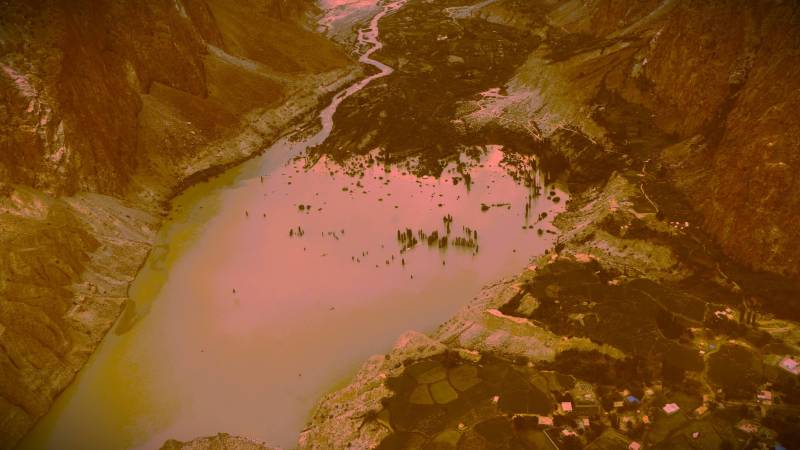
The summer this year was calm. Despite the occasional rainfall and humid conditions, there were no reports of significant glacial lake outburst incidents in Khyber Pakhtunkhwa (KP) or Gilgit Baltistan (GB).
The northern areas of Pakistan, renowned for their scenic beauty and untapped potential for tourism, confront regular threats of global warming and glacial melting. These environmental challenges result in recurrent flooding in the country, causing permanent population displacement and significant economic losses.
Pakistan, home to the largest number of glaciers in the world, is particularly vulnerable to rapid glacial lake outburst flooding (GLOF). This phenomenon has already displaced a significant population in various parts of Khyber Pakhtunkhwa (KP) and Gilgit-Baltistan (GB), as large and medium-sized lakes have been created, submerging towns and villages in these mountainous regions of Pakistan.
Noted meteorologist Dr Muhammad Hanif warns, “In Pakistan, the frequency and intensity of GLOF events are increasing by 20 percent every year due to global warming and local factors, such as deforestation and human interference in stable glacier regions.”
Dr Hassan Abbas suggests, “The best management approach is to monitor the glacial lakes forming ahead of receding glaciers. Additionally, areas at risk of high-energy deluges must be scientifically delineated, and risk management plans for dwellings, assets, and infrastructure should be developed. People should be relocated from harm’s way since no man-made structure can withstand the energy of a GLOF.”
Gilgit-Baltistan, known for the world's second-highest peak, K2, and formidable mountains such as Nanga Parbat and Rakaposhi, is also the confluence of three famous mountain ranges – Himalayas, Karakoram, and Hindu Kush. The region is home to numerous glaciers, including Siachen, Baltoro, Batura, Biafo, Biarchedi, Bilafond, and many more.
Due to rising temperatures, glaciers in these northern mountain ranges are melting rapidly. According to data from the Pakistan Federal Ministry of Climate Change and Environmental Coordination, the situation regarding GLOF is grim.
Dr Hassan Abbas, a renowned hydrologist, explains, “Climate change is causing some valleys in the Upper Indus Basin to become warmer, leading to higher snow lines during summers and a failure to reach the End Moraines. This results in the formation of larger glacial lakes ahead of glaciers where snow lines have moved."
The Ministry reports that a total of 3,044 glacial lakes have developed in GB and KP, with 33 of them being assessed as prone to hazardous GLOFs. This puts the lives of nearly 7.1 million people in GB and KP at risk, with a significant portion living below the poverty line.
Flash floods resulting from GLOFs are sudden events that can release millions of cubic metres of water and debris, leading to the loss of lives, property, and livelihoods among remote and impoverished mountain communities.
Dr Hassan Abbas suggests, “The best management approach is to monitor the glacial lakes forming ahead of receding glaciers. Additionally, areas at risk of high-energy deluges must be scientifically delineated, and risk management plans for dwellings, assets, and infrastructure should be developed. People should be relocated from harm’s way since no man-made structure can withstand the energy of a GLOF.”
In addition to climate change and rising temperatures, the region is prone to earthquakes. Glacial lake outburst flooding from KP to GB has always been vulnerable to the risks of earthquakes of various magnitudes.
Satellite research indicates that glaciers in the Himalayas have been losing almost one and a half vertical feet of ice per year since 2000. The research underscores, “If a population resides fewer than 20 kilometers downstream of a glacier lake, the hazard is greater”, thus necessitating careful monitoring and preparation to prevent casualties.
While glacial lake outbursts are not new in northern Pakistan, they have been on the rise over the past two decades, causing loss of life and property in KP and GB.
Pakistan, in addition to seeking global support for addressing GLOFs, has taken steps to reduce its risks. The GLOF-1 project was launched to assist vulnerable communities in preparing for GLOF risks and enhancing infrastructure for risk management through an early warning system. To further scale up GLOF risk reduction in KP and GB, the GLOF II project was introduced in 2017.
“Around 250 engineering structures, including dams, ponds, spillways, tree plantations, and drainage, are needed to reduce risk,” according to the UNDP. The project also involves developing disaster management policies and introducing weather monitoring stations, flood gauges, hydrological modelling, and early warning systems to enhance the capacity to respond rapidly to flood situations.
The global community has responded promptly to Pakistan's needs, pledging over $9 billion to aid in the recovery of populations affected by the 2022 flooding, which resulted in the loss of 1,700 lives, displaced 8 million people, and caused extensive infrastructure damage.

